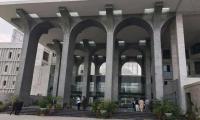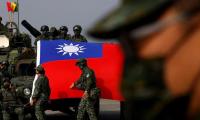Let’s begin with what democracy is. We may define it as the will of the people expressed by their votes and exercised by their representatives. The will of the people may or may not be according to the liking or disliking of the civil and military bureaucracy.
The will of the people may also be contrary to the decisions of the courts; it may also run against the current of the establishment. To subvert the will of the people, there are various avenues available to the civil and military bureaucracy, and to judges and generals.
If these avenues are not readily available, they need to be carved out either with a gavel or with a gun. One such method is to not hold elections at all so that the people cannot express their will. Another is to hold elections but then put the entire exercise in question before, during, or after the elections. Before the elections, you may use the gavel to excise the undesirable elements. You may delay the required legislation needed to conduct timely elections. You may use the gun – or similar violent means – to exclude people from participating in political gatherings and rallies.
To prevent people from expressing their will during the voting process, entire polling stations can be hijacked, stuffed with bogus votes and certain segments of the constituency, such as women and minorities, can be disenfranchised. After the elections, such incidents can be used to call the elections into question, massive rigging can be alleged and a newly elected parliament can be dubbed a sham. The elected representatives of the people may be declared a bunch of crooks and criminals. Sit-ins, supported by both the gavel and the gun, can be staged.
And while democracy trembles, the trouble-makers can be rewarded in cash and kind. The gun can be turned on peace-loving people but not at the miscreants. The gavel can tolerate the outbursts of bigots against the judiciary and against democracy itself, it can even overlook an outright rebellion on the streets and then call the elected civilian government to answer for the trouble that unelected and undemocratic forces create. And even then if a democratically elected government survives, its entire term can be put on tenterhooks – always wondering if it will be allowed to complete its tenure.
It is in this background that we should try to understand the entire history of Pakistan, especially recent developments. When Pakistan came into being, the constitution-making process was delayed and then derailed repeatedly for almost a decade. The will of the people was never allowed to be expressed, and when it was – such as the victory of the Jagtu Front in East Pakistan in 1954 – the newly elected chief minister, A K Fazlul Haq, was sent packing within a couple of months. When the constitution was finally promulgated in 1956, the elections were postponed and then the constitution itself was abrogated.
In this process, both the gavel and the gun were not with the people. They were with the powers that be. When the self-appointed field marshal and president, General Ayub Khan, massively rigged the presidential election in 1965 against Fatima Jinnah, with the help of his guns, the gavel didn’t do anything. When the constitution of 1962 was violated by its own maker in 1969, the gavel kept quiet then too. The takeover of General Yahya Khan was declared null and void in the famous Asma Jilani case, but it was too little and too late. By that time, the good general was happily ensconced at home and no retrospective punishment was given.
The civil war of 1971 saw extreme brutalities, and those responsible were clearly identified in the Hamoodur Rahman Commission Report, but no court convicted any of the culprits. When Z A Bhutto was mutilating the constitution, no court took any action, rather his unconstitutional and undemocratic acts – such as the imposition of a ban on the National Awami Party and military action in Balochistan – were sanctified by the courts. When Bhutto himself became a target of the coup staged by General Zia, the gavel was again found to be sleeping. It became active, but only against Bhutto.
All constitutional, democratic, and legal norms were violated blatantly by General Zia but the courts toed his line. The judicial murder of Bhutto was a mockery of justice staged by both generals and judges. Even now, the case stands out as a notorious example of how justice can be manipulated to violate the will of the people and to exclude leaders who command the people’s respect, irrespective of the mistakes they may or may not have committed. Even within the judicial community, the Bhutto case is cited as a flaw and not as a feather.
During the 11-year dictatorship of General Zia, the constitution was mutilated beyond recognition, but no judge spoke for the supremacy of the constitution. In the shape of multiple new legislations – enacted not by a democratically elected parliament but by the general and his stooges – minorities were marginalised, women were sidelined and free expression of faith and fundamental human rights were strangulated. But the ‘basic structure of the constitution’ was not defended by any judge sitting on the benches. The farcical ‘Majlis-e-Shura’ was not challenged while it passed amendments and legitimised General Zia’s orders that violated the Universal Declaration of Human Rights.
When his own hand-picked prime minister was dismissed by General Zia, the court declared it unconstitutional only after the general was dead and buried. Even then, Junejo was not restored by the gavel, for fear of the gun. No retrospective punishment was meted out to any of the lackeys who stood by the general throughout his 11-year constitutional, legal and social rampage. Then Ghulam Ishaq Khan, the paragon of bureaucracy in Pakistan, played havoc with democracy in the country. But again, both the gavel and the gun supported him at the cost of democracy.
When Chief Justice Sajjad Ali Shah was removed by his own brother judges, no retrospective enforcement was ordered that could declare the ‘inappropriately appointed’ chief justice’s decisions invalid. The two-third majority enjoyed by Nawaz Sharif in parliament was thrown in the bin by General Musharraf in 1999, resulting in yet another constitutional chaos and derailment of democracy. Still the apex court and its judges were ready to side with the dictator rather than with democracy. Once again, ‘the basic structure of the constitution’ was thoroughly overhauled but the PCO judges were busy saving their own skin.
Perhaps the only chief justice who stood up against a dictator was Justice Iftikhar M Chaudhary, but he squandered his opportunity to take a dictator to task. Justice Chaudhary never challenged those who stood with General Musharraf, neither did he stop the general from getting himself elected as president, once again making a mockery of the entire process. But the chief justice went into overdrive when an elected government took power. The entire fiver-year term of the PPP government was marred by a judiciary that was too keen on making executive decisions at the cost of the government.
The recent decision of the Supreme Court to disqualify Nawaz Sharif from his party leadership cannot be understood in isolation. It is the continuation of the same 70-year process that has repeatedly weakened and shaken democracy in Pakistan.
Email: Mnazir1964@yahoo.co.uk
The writer holds a PhD from the
University of Birmingham, UK and works in Islamabad.
Chinese philosopher Mencius prophesized 3000 years ago that state that does not employ worthy perishes
Over past two decades, rapid and often chaotic development has increasingly defined Islamabad's landscape
Donald Trump's entry into White House is going to be stormy
Most notable is dangerous surge in conflict at scale not seen since last world war
Coordinated attacks sent wave of insecurity across country, tarnished Pakistan's image globally
For now, IMF agreement provides essential cushion to help Pakistan return from the brink of Sri-Lanka-type default on...







